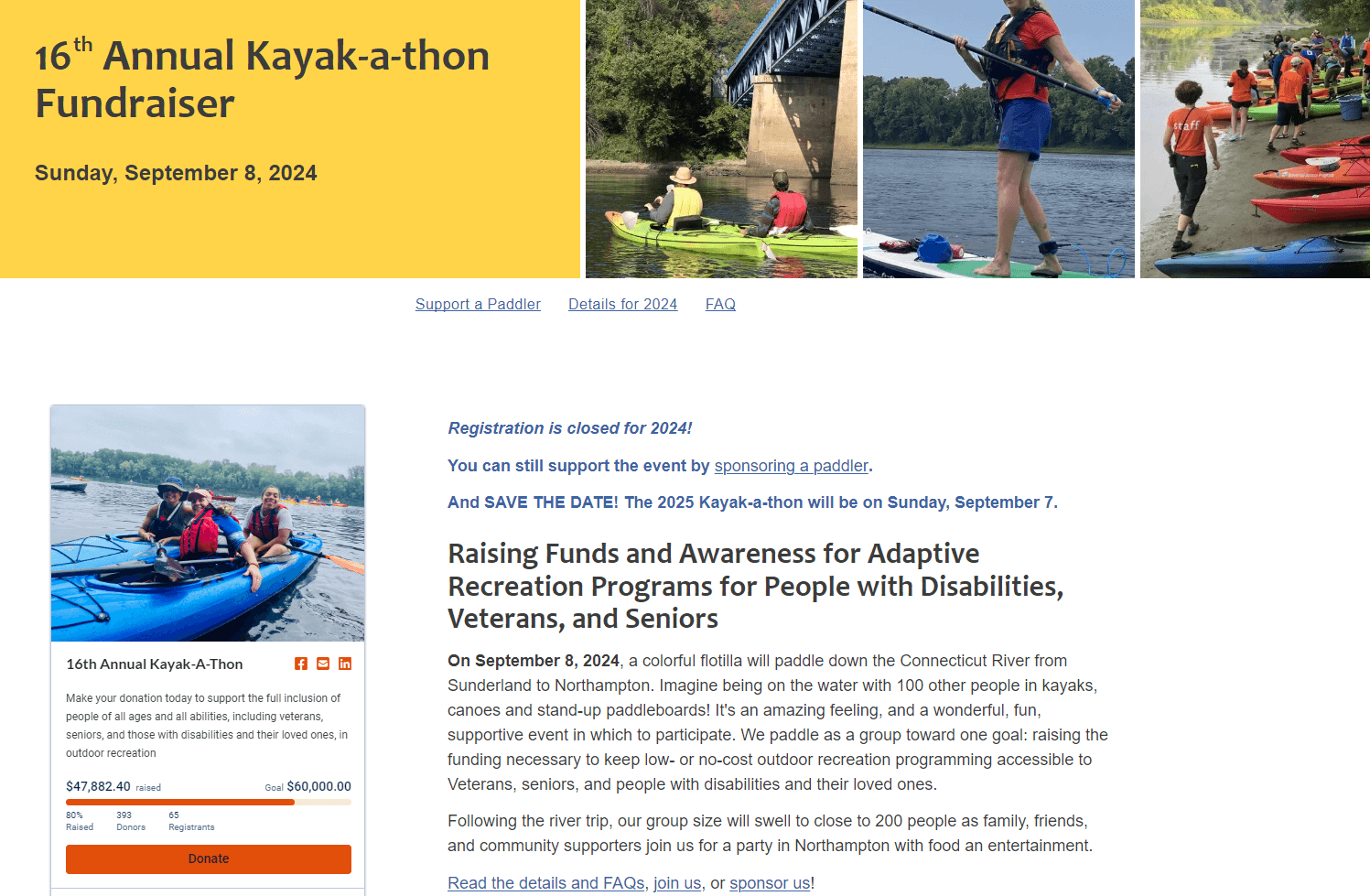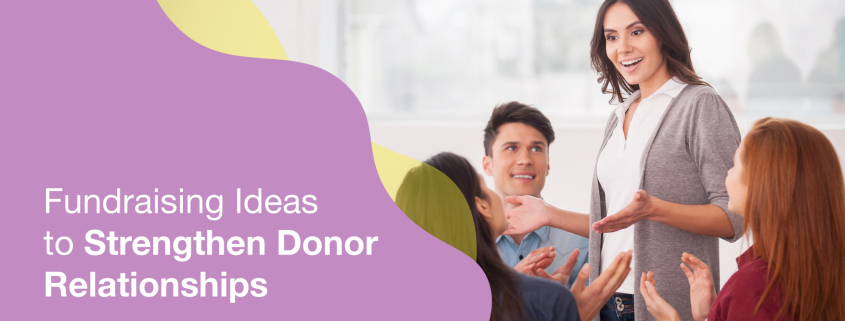6 Fundraising Ideas to Strengthen Donor Relationships
The importance of donor relationships is no mystery to nonprofit leaders. A strong connection between donors and nonprofits often leads to increased engagement and a greater sense of community among supporters. But how can your nonprofit focus on cultivating these connections while raising money for its cause?
In this guide, we’ll explain the role fundraising can play in donor engagement and review six effective fundraising ideas to simultaneously strengthen donor relationships and fund your work.
How can fundraisers help you engage and retain donors?
Fundraisers aren’t just about asking for money. While the main goal is to raise funds for your cause, strategic fundraising campaigns are also opportunities to empower donors, bring communities together, demonstrate your impact, and so much more. The right fundraisers can be powerful tools for engaging and retaining donors long-term.
Specifically, you can use your fundraising campaigns to strengthen relationships by:
- Learning more about donors’ interests and passions at fundraising events.
- Encouraging supporters to take the lead on fundraising and deepen their involvement with your nonprofit.
- Emphasizing the impact you’ve achieved together with their donations and your organization’s work.
- Giving donors a glimpse into your nonprofit’s future goals, plans, and priorities.
As we explore these fundraising ideas, think about how you might incorporate donor engagement strategies into each one. We’ll discuss a few strategies you can try, but remember that your organization is the expert on your unique donor base—zero in on the tactics you know will resonate with your donors most. Now, let’s dive into our fundraising ideas!
1. Peer-to-Peer Campaigns
One of the most important parts of relationship building is understanding the other person’s perspective. This is why your nonprofit should work to learn more about each supporter and the motivations behind their involvement. Donors who feel recognized and valued will ultimately be more engaged in your organization long-term.
Peer-to-peer campaigns are an effective way to have direct interactions with your supporters in order to learn more about why they love your organization. These campaigns raise money through the advocacy of your supporters, who recruit their friends and family members to donate to your organization. Volunteer fundraisers create and share their own personal campaign pages, typically on social media, through which their peers can donate to your nonprofit.
There are two types of peer-to-peer campaigns your nonprofit might host:
- Rolling campaign: This is a peer-to-peer campaign with no time limit. Since they have no deadline, these campaigns can operate alongside other fundraising events and initiatives (think Facebook birthday campaigns).
- Time-based campaign: These campaigns raise money by a predetermined deadline and are often tied to events.
In either campaign format, you can see how donors talk about and advocate for your nonprofit. But to build strong relationships, communication must go both ways. By explaining your cause and how donors should advocate for it, donors will understand more about your organization’s perspective and deepen their connection to your cause.
2. Product Fundraisers
Most people enjoy receiving a little something in return for their donations. Not only does this incentivize giving, but it also helps you connect with donors in a memorable way by offering a tangible gift in return for their contributions.
Product fundraisers allow nonprofits to do just that. By selling various products to supporters, your nonprofit will not only raise money for its cause but also offer a gift to donors. Nonprofits can sell a wide variety of products for this type of fundraiser, including:
- Branded merchandise like t-shirts, water bottles, or stickers with your nonprofit’s branding.
- Food, such as cookie dough, popcorn, chocolate bars, and other snacks.
- Seasonal items, including candles or Christmas ornaments for the holiday season or flower bulbs for spring.
This fundraising idea also naturally lends itself to pairing with other fundraising events, giving you double the opportunities to raise funds and engage donors. For instance, ABC Fundraising suggests hosting a cookie-making event or bake sale at the end of a cookie dough fundraiser to maximize your fundraising potential.
3. A-Thon Events
Community fundraising events like A-thons place the focus solely on connection and socialization, enabling you to easily strengthen donor relationships while you collect donations.
A-Thon events are challenge-based activities that raise money and engage supporters through healthy competition. Any variation of this fundraiser works by establishing a challenge and having donors collect pledges from family and friends dependent on their performance in the challenge. Nonprofits can make almost any activity an A-Thon event, from traditional walk-a-thons to specialized bake-a-thons and dance-a-thons.
Since these events are highly customizable, they’re a creative opportunity for nonprofits to learn about and tap into their donors’ interests and hobbies. You can also easily align them with your nonprofit’s mission to boost donors’ feelings of connection. For example, take a look at how All Out Adventures connects supporters to its adaptive recreation programs with a kayak-a-thon:

4. Galas
Challenging activities engage supporters because of the excitement of participating in the activity. In contrast, high-end fundraising events are a calmer opportunity for your nonprofit to build relationships with its donors without the distraction of a high-energy activity.
Both in-person and virtual galas can raise money for your nonprofit’s cause while also allowing your organization’s leaders to speak with donors one-on-one and learn more about them and their families. For light entertainment, your gala could include:
- Keynote speakers: Recruit one of your organization’s leaders or hire a professional speaker to give a speech related to your nonprofit’s work and the significance of your cause.
- Raffles or auctions: Consider selling raffle tickets to win special prizes, like a gift basket or discounts at local establishments.
- Local bands: Invite a local band to provide live music and connect donors with the community.
- Unique performances: Find unique entertainment, like a comedian or magician, to give a special performance at your event.
While attendees eat and enjoy the entertainment, your nonprofit’s leaders can focus on mingling and getting to know each supporter. This event type also allows donors to socialize with each other, which can further strengthen the community within your nonprofit.
5. Donor-Driven Campaigns
This twist on peer-to-peer fundraising allows your donors to bring their campaign visions to life. And, with the right training and resources from your nonprofit, their passion for your cause can greatly boost your funds. Here’s how a donor-driven campaign works:
- Open your donor-driven campaign program to your supporter base and collect signups.
- Once the signup window has closed, gather your participants for a fundraising training session. During this session, donors pick what they want their campaign to look like, set goals, and start crafting outreach materials.
- Give your participants resources to succeed. These will vary based on the participant’s fundraising idea, but you can provide them a profile on your peer-to-peer fundraising website to start. Also, offer them templates for emails and social media posts so participants can market their personal campaigns more effectively.
- Offer coaching throughout the campaign. Set up short meetings with your participants to answer questions and provide advice so they can hit their fundraising goals.
This empowering fundraising idea works because you give donors complete control over how they want to collect gifts and conduct outreach. This flexibility allows them to play to their strengths and builds their personal investment in your cause.
Your nonprofit can also leverage this program to demonstrate donor appreciation. Giving donors control over how they run their campaigns shows them how much you value their passion for your mission. You can also formally show appreciation by hosting a thank-you banquet for all participants after the campaign ends, no matter how successful their personal campaigns were.
6. Volunteer Grants
What better way to strengthen relationships with donors than through volunteering? With volunteer grants, you can encourage donors to increase their involvement by volunteering and donating money without dipping into their own pockets.
360MatchPro defines volunteer grants as “a type of corporate giving program wherein businesses donate to the nonprofits their employees volunteer with.” Essentially, companies that run these programs commit to donating a specific amount of money to your nonprofit when their employees volunteer and report their hours. For instance, a volunteer might earn $50 for your nonprofit for every 15 hours they volunteer, or they might earn a $200 grant after reaching a certain hour threshold.
This fundraising idea shows donors that they can support your nonprofit in a multitude of ways, and it provides opportunities to get to know donors better by interacting with them at in-person volunteer events. To promote this fundraiser, simply let donors know that they might be eligible for volunteer grants and provide information about how they can request a grant.
Nonprofits are always looking for creative ways to raise money, but the most important part of fundraising is cultivating strong relationships with donors. After all, donors are the lifeblood of your organization’s operations. With these fundraising ideas, you can genuinely pursue deeper connections with supporters and celebrate all they do for your organization.




